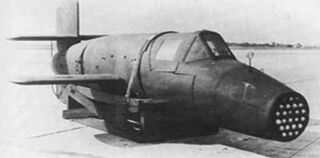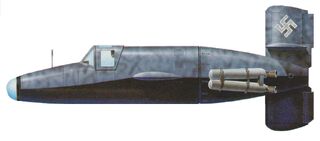
The Bachem Ba 349 Natter (English: Colubrid, grass-snake) was a World War II German point-defence rocket powered interceptor, which was to be used in a very similar way to a manned surface-to-air missile. After a vertical take-off, which eliminated the need for airfields, the majority of the flight to the Allied bombers was to be controlled by an autopilot. The primary mission of the relatively untrained pilot, was to aim the aircraft at its target bomber and fire its armament of rockets. The pilot a

nd the fuselage containing the rocket motor would then land under separate parachutes, while the nose section was disposable. The only manned vertical take-off flight on 1 March 1945 ended in the death of the test pilot, Lothar Sieber.
Development[]
In 1943 with Luftwaffe air superiority being challenged by the Allies over the Reich, radical innovations were required to overcome the crisis. Surface-to-air missiles appeared to be a promising approach to counter the Allied strategic bombing offensive; a variety of projects were started, but invariably problems with the guidance and homing systems prevented any of these from attaining operational status. Providing the missile with a pilot, who could operate a weapon during the brief terminal approach phase, offered a solution. Submissions for a simple target defence interceptor were requested by the Luftwaffe in early 1944 under the umbrella of the "Emergency Fighter Program". A number of simple designs were proposed, including the Heinkel P.1077 Julia, in which the pilot lay prone (on his stomach), to reduce the frontal area. The Julia was the front-runner for the contract. The initial plan was to launch the aircraft vertically, but this concept was later changed to a conventional horizontal take-off from a tricycle-wheeled trolley, similar to that used by the first eight prototypes of the Arado Ar 234 jet reconnaissance bomber.